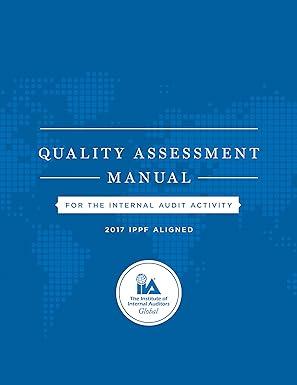Question
1. The price-earnings ratio measures the premium investors are willing to pay for a company's stock relative to its earnings. True False 2.The best reason
1. The price-earnings ratio measures the premium investors are willing to pay for a company's stock relative to its earnings.
True False
2.The best reason to use a common-size analysis is to assess nonfinancial measures of performance.
True False
3.On a common-size balance sheet, equipment should be stated as a percentage of total assets.
True False
4.On a common-size income statement, net income should be stated as a percentage of gross margin.
True False
5.All of the following are nonfinancial measures that might be used by transportation companies such as FedEx:
a. percentage of damage-free goods.
b. percentage of on-time deliveries.
c. average collection period.
d. hours of employee training.
True False
6.All of the following measures focus on short-term liquidity:
a. current ratio.
b. debt to assets ratio.
c. quick ratio.
d. receivables turnover ratio.
True False
7.Savanah Company reported the following amounts of net income.
Year 1
$49,187
Year 2
$52,553
Year 3
$52,061
What is the percentage change in net income from Year 2 to Year 3? Answer to nearest two decimal places without any commas or words (e.g. 1.25 not 1.25 increase or 125%). Enter a negative number as -10 not (10).
8.Dresden Inc. has net sales of $120,947, cost of goods sold of $89,992, operating expenses of $22,842, interest expense of $3,252, and income tax expense of $1,052. The company's gross margin ratio is Answer to nearest two decimal places without any commas or words (e.g. 1.25 not 1.25 increase or 125%). Enter a negative number as -10 not (10).
9. Filmore Inc. has the following information available for 2012 and 2013:
2012 2013
Current liabilities $250,000 $400,000
If you were performing a trend analysis on this information, you would say that current liabilities have increased by 62.5%.
True False
10.Companies with higher inventory turnover ratios tend to have lower inventory costs, including lower inventory storage and insurance costs, than companies with lower inventory turnover ratios.
True False
Step by Step Solution
There are 3 Steps involved in it
Step: 1

Get Instant Access to Expert-Tailored Solutions
See step-by-step solutions with expert insights and AI powered tools for academic success
Step: 2

Step: 3

Ace Your Homework with AI
Get the answers you need in no time with our AI-driven, step-by-step assistance
Get Started


